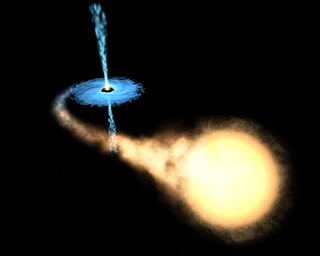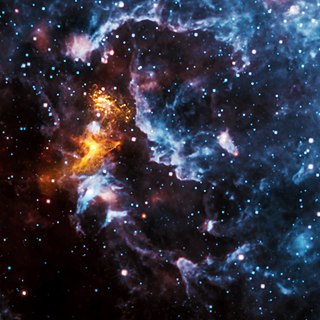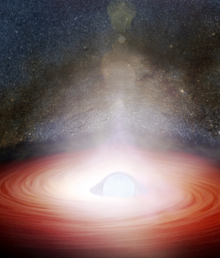
A neutron star is the collapsed core of a massive supergiant star, which had a total mass of between 10 and 25 solar masses (M☉), possibly more if the star was especially metal-rich. Except for black holes, neutron stars are the smallest and densest known class of stellar objects. Neutron stars have a radius on the order of 10 kilometers (6 mi) and a mass of about 1.4 M☉. They result from the supernova explosion of a massive star, combined with gravitational collapse, that compresses the core past white dwarf star density to that of atomic nuclei.

Stellar evolution is the process by which a star changes over the course of time. Depending on the mass of the star, its lifetime can range from a few million years for the most massive to trillions of years for the least massive, which is considerably longer than the current age of the universe. The table shows the lifetimes of stars as a function of their masses. All stars are formed from collapsing clouds of gas and dust, often called nebulae or molecular clouds. Over the course of millions of years, these protostars settle down into a state of equilibrium, becoming what is known as a main-sequence star.

X-ray binaries are a class of binary stars that are luminous in X-rays. The X-rays are produced by matter falling from one component, called the donor, to the other component, called the accretor, which is either a neutron star or black hole. The infalling matter releases gravitational potential energy, up to 30 percent of its rest mass, as X-rays. The lifetime and the mass-transfer rate in an X-ray binary depends on the evolutionary status of the donor star, the mass ratio between the stellar components, and their orbital separation.
In astronomy, the term compact star refers collectively to white dwarfs, neutron stars, and black holes. It would grow to include exotic stars if such hypothetical, dense bodies are confirmed to exist. All compact objects have a high mass relative to their radius, giving them a very high density, compared to ordinary atomic matter.

A pulsar is a highly magnetized rotating neutron star that emits beams of electromagnetic radiation out of its magnetic poles. This radiation can be observed only when a beam of emission is pointing toward Earth, and is responsible for the pulsed appearance of emission. Neutron stars are very dense and have short, regular rotational periods. This produces a very precise interval between pulses that ranges from milliseconds to seconds for an individual pulsar. Pulsars are one of the candidates for the source of ultra-high-energy cosmic rays.

An astrophysical jet is an astronomical phenomenon where outflows of ionised matter are emitted as extended beams along the axis of rotation. When this greatly accelerated matter in the beam approaches the speed of light, astrophysical jets become relativistic jets as they show effects from special relativity.

A millisecond pulsar (MSP) is a pulsar with a rotational period less than about 10 milliseconds. Millisecond pulsars have been detected in radio, X-ray, and gamma ray portions of the electromagnetic spectrum. The leading theory for the origin of millisecond pulsars is that they are old, rapidly rotating neutron stars that have been spun up or "recycled" through accretion of matter from a companion star in a close binary system. For this reason, millisecond pulsars are sometimes called recycled pulsars.

PSR J0737−3039 is the first known double pulsar. It consists of two neutron stars emitting electromagnetic waves in the radio wavelength in a relativistic binary system. The two pulsars are known as PSR J0737−3039A and PSR J0737−3039B. It was discovered in 2003 at Australia's Parkes Observatory by an international team led by the Italian radio astronomer Marta Burgay during a high-latitude pulsar survey.
The Tolman–Oppenheimer–Volkoff limit is an upper bound to the mass of cold, non-rotating neutron stars, analogous to the Chandrasekhar limit for white dwarf stars. If the mass of a neutron star reaches the limit it will collapse to a denser form, most likely a black hole.
Rotating radio transients (RRATs) are sources of short, moderately bright, radio pulses, which were first discovered in 2006. RRATs are thought to be pulsars, i.e. rotating magnetised neutron stars which emit more sporadically and/or with higher pulse-to-pulse variability than the bulk of the known pulsars. The working definition of what a RRAT is, is a pulsar which is more easily discoverable in a search for bright single pulses, as opposed to in Fourier domain searches so that 'RRAT' is little more than a label and does not represent a distinct class of objects from pulsars. As of March 2015 over 100 have been reported.

A radio-quiet neutron star is a neutron star that does not seem to emit radio emissions, but is still visible to Earth through electromagnetic radiation at other parts of the spectrum, particularly X-rays and gamma rays.

Vela X-1 is a pulsing, eclipsing high-mass X-ray binary (HMXB) system, associated with the Uhuru source 4U 0900-40 and the supergiant star HD 77581. The X-ray emission of the neutron star is caused by the capture and accretion of matter from the stellar wind of the supergiant companion. Vela X-1 is the prototypical detached HMXB.

A Type II supernova or SNII results from the rapid collapse and violent explosion of a massive star. A star must have at least eight times, but no more than 40 to 50 times, the mass of the Sun (M☉) to undergo this type of explosion. Type II supernovae are distinguished from other types of supernovae by the presence of hydrogen in their spectra. They are usually observed in the spiral arms of galaxies and in H II regions, but not in elliptical galaxies; those are generally composed of older, low-mass stars, with few of the young, very massive stars necessary to cause a supernova.
The Magnificent Seven is the informal name of a group of isolated young cooling neutron stars at a distance of 120 to 500 parsecs from Earth. These objects are also known under the names XDINS or simply XINS.
RRAT J1819-1458 is a Milky Way neutron star and the best studied of the class of rotating radio transients (RRATs) first discovered in 2006.

IGR J11014−6103, also called the Lighthouse Nebula, is a pulsar wind nebula trailing the neutron star which has the longest relativistic jet observed in the Milky Way.

A hypernova is a very energetic supernova which is believed to result from an extreme core-collapse scenario. In this case, a massive star collapses to form a rotating black hole emitting twin astrophysical jets and surrounded by an accretion disk. It is a type of stellar explosion that ejects material with an unusually high kinetic energy, an order of magnitude higher than most supernovae, with a luminosity at least 10 times greater. They usually appear similar to a type Ic supernova, but with unusually broad spectral lines indicating an extremely high expansion velocity. Hypernovae are one of the mechanisms for producing long gamma ray bursts (GRBs), which range from 2 seconds to over a minute in duration. They have also been referred to as superluminous supernovae, though that classification also includes other types of extremely luminous stellar explosions that have different origins.

Richard Van Evera Lovelace is an American astrophysicist and plasma physicist. He is best known for the discovery of the period of the pulsar in the Crab Nebula, which helped to prove that pulsars are rotating neutron stars, for developing a magnetic model of astrophysical jets from galaxies, and for developing a model of Rossby waves in accretion disks. He organized a US-Russia collaboration in plasma astrophysics, which focused on modeling of plasma accretion and outflows from magnetized rotating stars.
Ken'ichi Nomoto is a Japanese astrophysicist and astronomer, known for his research on stellar evolution, supernovae, and the origin of heavy elements.













